How to avoid falling for scams like "DHL - Incoming Shipment Notification"
![]() Written by Tomas Meskauskas on (updated)
Written by Tomas Meskauskas on (updated)
What is "DHL - Incoming Shipment Notification"?
Our investigation indicates that this email is a fraudulent message impersonating DHL, falsely presented as a notification about an incoming shipment. The scammers behind this deceptive email aim to entice recipients into divulging personal information on a misleading website. Such emails fall under the category of phishing emails.
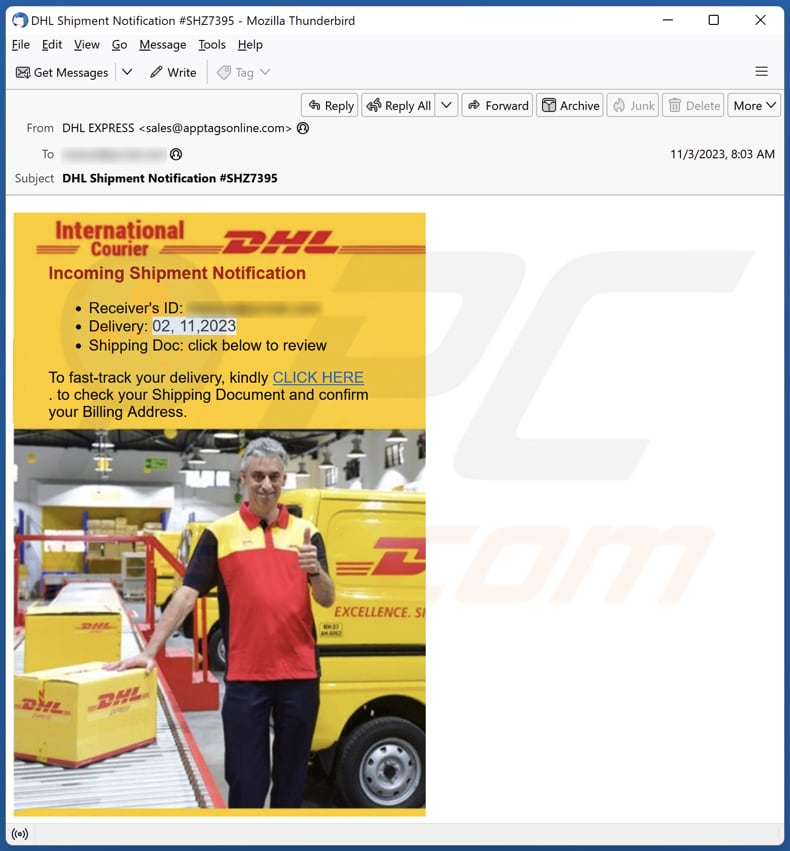
More about the "DHL - Incoming Shipment Notification" scam email
This phishing email has the subject "DHL Shipment Notification #SHZ7395" and appears to impersonate the DHL international courier. It claims to provide an incoming shipment notification specifying a delivery date of November 2, 2023 (the date may vary). The email encourages the recipient to review the supposed shipping document by clicking a link purportedly to fast-track the delivery process.
However, the true intention of the email is to deceive individuals into clicking the link, leading them to a deceptive website where scammers attempt to gather personal information. On that page, users are requested to enter email account login credentials such as the email address and password.
It is noteworthy to highlight that the webpage accessed through the link in the email mirrors an email service provider based on the recipient's email address. For example, if the recipient utilizes Gmail, the fraudulent page replicates the Gmail sign-in interface. Either way, the ultimate goal is to steal email account login credentials.
When scammers successfully acquire login credentials for email accounts, they gain unauthorized access to the individual's personal and sensitive information. Scammers may exploit the compromised email account to send phishing emails to the victim's contacts, attempting to trick them into revealing more personal information or financial details.
Additionally, access to email accounts provides scammers with a gateway to other online accounts linked to the same email address, potentially compromising a user's banking, social media, or other critical accounts.
Moreover, the perpetrators may utilize the pilfered credentials to gain illicit entry to sensitive information, encompassing confidential messages, personal documents, or login details for various online services. In certain instances, these scammers might opt to vend the acquired login credentials on the dark web, thereby fueling a larger network of cybercriminal activities.
| Name | DHL - Incoming Shipment Notification Email Scam |
| Threat Type | Phishing, Scam, Social Engineering, Fraud |
| Fake Claim | Attached file contains shipping information |
| Disguise | Letter from DHL |
| Symptoms | Unauthorized online purchases, changed online account passwords, identity theft, illegal access of the computer. |
| Distribution methods | Deceptive emails, rogue online pop-up ads, search engine poisoning techniques, misspelled domains. |
| Damage | Loss of sensitive private information, monetary loss, identity theft. |
| Malware Removal (Windows) | To eliminate possible malware infections, scan your computer with legitimate antivirus software. Our security researchers recommend using Combo Cleaner. |
Similar scam emails in general
Typically, they employ urgent or enticing language to create a sense of immediacy, prompting recipients to act hastily. These emails often mimic trusted entities, such as banks or email service providers, using logos and formatting to appear authentic. Included hyperlinks (or attachments) direct users to deceptive websites, aiming to collect login credentials or other details.
Examples of phishing campaigns are "Truist Online Banking Profile", "Password Needs To Be Retained Urgently", and "IMAP Termination Process".
How do spam campaigns infect computers?
Computer infections via email occur when users engage with malicious components like attachments or links. Malware is often concealed within seemingly innocuous attachments, and when users open them, it can infiltrate their computers. Clicking on links in emails can also result in the downloading and activation of malware.
Cybercriminals use executable and JavaScript files, documents like PDFs or Office documents, ISO files, archives, etc., to disseminate malware through email.
How to avoid installation of malware?
Steer clear of launching attachments or clicking on links in emails that appear suspicious, especially those from unfamiliar sources or with irrelevant content. Ensure the continual updating of your operating system, installed programs, and antivirus software, and conduct routine scans on your computer for added security.
Exercise prudence when downloading files or programs from the internet, relying solely on reputable sources like official pages and app stores. Be careful when browsing questionable websites, and refrain from engaging with dubious content such as suspicious ads, pop-ups, offers, or software updates. Never download pirated software, cracking tools, or key generators.
If you have already opened malicious attachments, we recommend running a scan with Combo Cleaner Antivirus for Windows to automatically eliminate infiltrated malware.
Text presented in the "DHL - Incoming Shipment Notification" email letter:
Subject: DHL Shipment Notification #SHZ7395
International Courier
DHLIncoming Shipment Notification
Receiver's ID: -
Delivery: 02, 11,2023
Shipping Doc: click below to reviewTo fast-track your delivery, kindly CLICK HERE . to check your Shipping Document and confirm your Billing Address.
Screenshot of the phishing website promoted via this email:
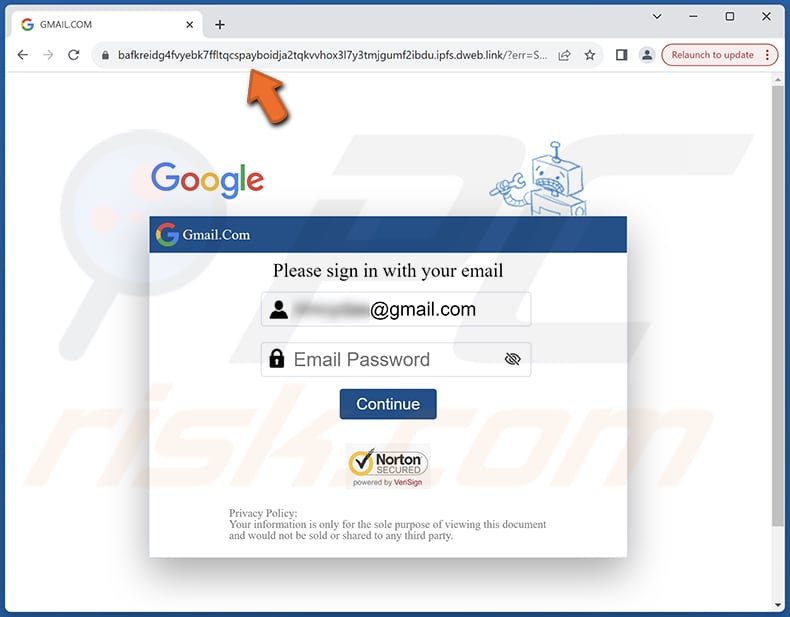
Another example of a DHL shipment notification-themed spam email promoting a phishing site:
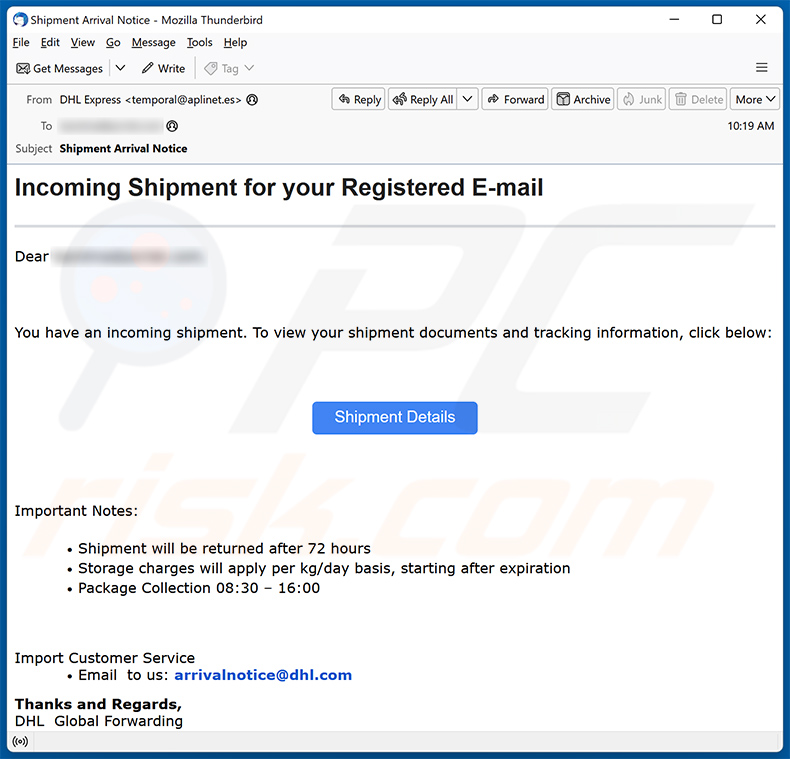
Text presented within:
Subject: Shipment Arrival Notice
Incoming Shipment for your Registered E-mail
Dear ********,You have an incoming shipment. To view your shipment documents and tracking information, click below:
Shipment Details
Important Notes:
Shipment will be returned after 72 hours
Storage charges will apply per kg/day basis, starting after expiration
Package Collection 08:30 – 16:00Import Customer Service
Email to us: arrivalnotice@dhl.com
Thanks and Regards,
DHL Global Forwarding
www.dhl.com
Screenshot of the promoted phishing site:
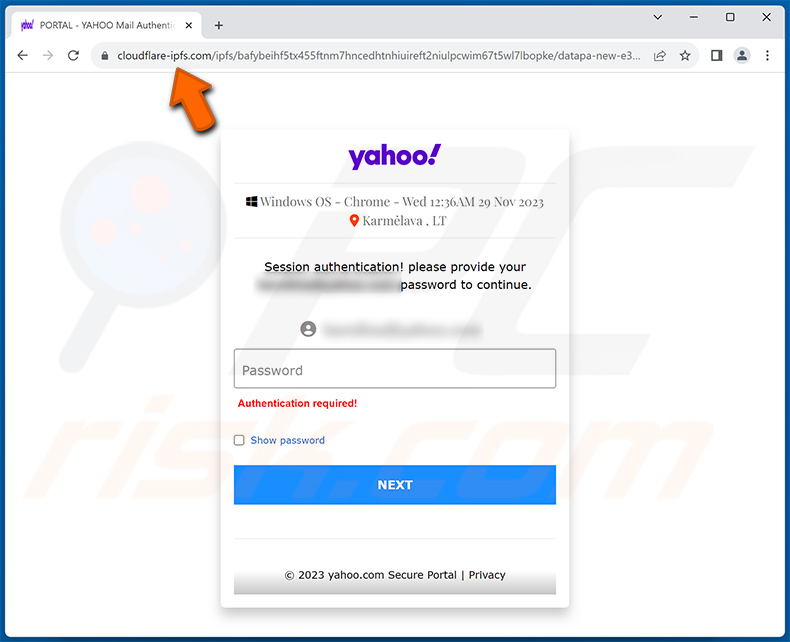
Screenshot of yet another email from "DHL - Incoming Shipment Notification" spam campaign:
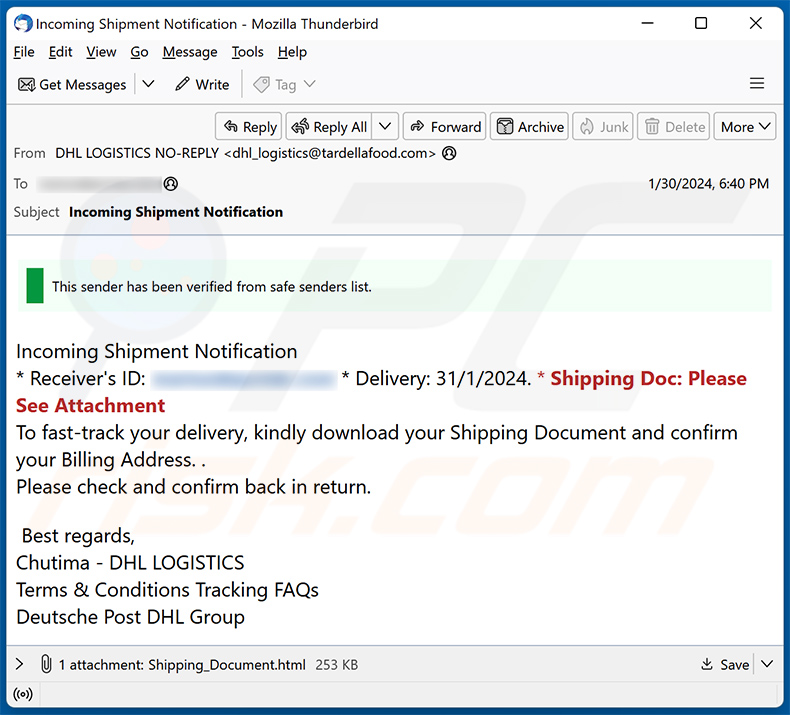
Text presented within:
Subject: Incoming Shipment Notification
This sender has been verified from safe senders list.
Incoming Shipment Notification
* Receiver's ID: ******** * Delivery: 31/1/2024. * Shipping Doc: Please See Attachment
To fast-track your delivery, kindly download your Shipping Document and confirm your Billing Address. .
Please check and confirm back in return.
Best regards,
Chutima - DHL LOGISTICS
Terms & Conditions Tracking FAQs
Deutsche Post DHL Group
Screenshot of the attached phishing HTML document:
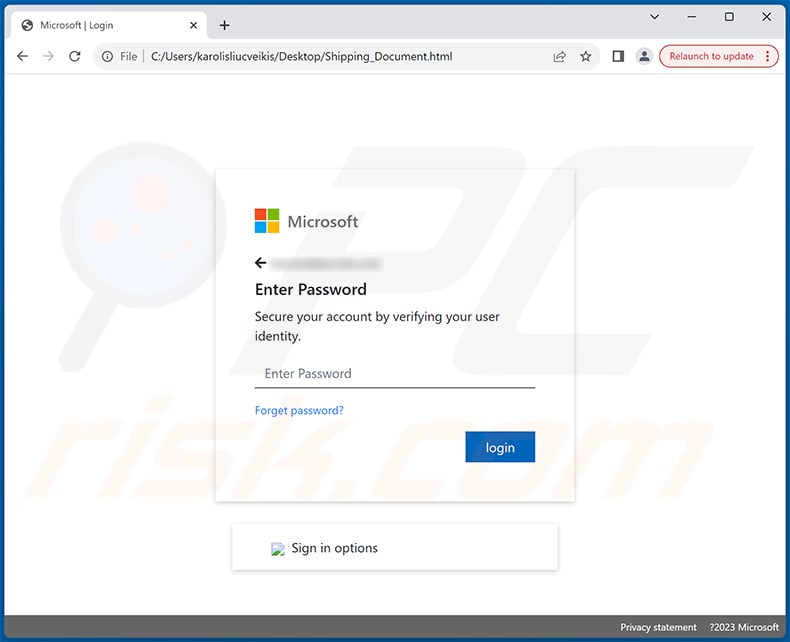
Instant automatic malware removal:
Manual threat removal might be a lengthy and complicated process that requires advanced IT skills. Combo Cleaner is a professional automatic malware removal tool that is recommended to get rid of malware. Download it by clicking the button below:
▼ DOWNLOAD Combo Cleaner
By downloading any software listed on this website you agree to our Privacy Policy and Terms of Use. To use full-featured product, you have to purchase a license for Combo Cleaner. 7 days free trial available. Combo Cleaner is owned and operated by Rcs Lt, the parent company of PCRisk.com read more.
Quick menu:
- What is DHL - Incoming Shipment Notification phishing campaign?
- Types of malicious emails.
- How to spot a malicious email?
- What to do if you fell for an email scam?
Types of malicious emails:
![]() Phishing Emails
Phishing Emails
Most commonly, cybercriminals use deceptive emails to trick Internet users into giving away their sensitive private information, for example, login information for various online services, email accounts, or online banking information.
Such attacks are called phishing. In a phishing attack, cybercriminals usually send an email message with some popular service logo (for example, Microsoft, DHL, Amazon, Netflix), create urgency (wrong shipping address, expired password, etc.), and place a link which they hope their potential victims will click on.
After clicking the link presented in such email message, victims are redirected to a fake website that looks identical or extremely similar to the original one. Victims are then asked to enter their password, credit card details, or some other information that gets stolen by cybercriminals.
![]() Emails with Malicious Attachments
Emails with Malicious Attachments
Another popular attack vector is email spam with malicious attachments that infect users' computers with malware. Malicious attachments usually carry trojans that are capable of stealing passwords, banking information, and other sensitive information.
In such attacks, cybercriminals' main goal is to trick their potential victims into opening an infected email attachment. To achieve this goal, email messages usually talk about recently received invoices, faxes, or voice messages.
If a potential victim falls for the lure and opens the attachment, their computers get infected, and cybercriminals can collect a lot of sensitive information.
While it's a more complicated method to steal personal information (spam filters and antivirus programs usually detect such attempts), if successful, cybercriminals can get a much wider array of data and can collect information for a long period of time.
![]() Sextortion Emails
Sextortion Emails
This is a type of phishing. In this case, users receive an email claiming that a cybercriminal could access the webcam of the potential victim and has a video recording of one's masturbation.
To get rid of the video, victims are asked to pay a ransom (usually using Bitcoin or another cryptocurrency). Nevertheless, all of these claims are false - users who receive such emails should ignore and delete them.
How to spot a malicious email?
While cyber criminals try to make their lure emails look trustworthy, here are some things that you should look for when trying to spot a phishing email:
- Check the sender's ("from") email address: Hover your mouse over the "from" address and check if it's legitimate. For example, if you received an email from Microsoft, be sure to check if the email address is @microsoft.com and not something suspicious like @m1crosoft.com, @microsfot.com, @account-security-noreply.com, etc.
- Check for generic greetings: If the greeting in the email is "Dear user", "Dear @youremail.com", "Dear valued customer", this should raise suspiciousness. Most commonly, companies call you by your name. Lack of this information could signal a phishing attempt.
- Check the links in the email: Hover your mouse over the link presented in the email, if the link that appears seems suspicious, don't click it. For example, if you received an email from Microsoft and the link in the email shows that it will go to firebasestorage.googleapis.com/v0... you shouldn't trust it. It's best not to click any links in the emails but to visit the company website that sent you the email in the first place.
- Don't blindly trust email attachments: Most commonly, legitimate companies will ask you to log in to their website and to view any documents there; if you received an email with an attachment, it's a good idea to scan it with an antivirus application. Infected email attachments are a common attack vector used by cybercriminals.
To minimise the risk of opening phishing and malicious emails we recommend using Combo Cleaner Antivirus for Windows.
Example of a spam email:

What to do if you fell for an email scam?
- If you clicked on a link in a phishing email and entered your password - be sure to change your password as soon as possible. Usually, cybercriminals collect stolen credentials and then sell them to other groups that use them for malicious purposes. If you change your password in a timely manner, there's a chance that criminals won't have enough time to do any damage.
- If you entered your credit card information - contact your bank as soon as possible and explain the situation. There's a good chance that you will need to cancel your compromised credit card and get a new one.
- If you see any signs of identity theft - you should immediately contact the Federal Trade Commission. This institution will collect information about your situation and create a personal recovery plan.
- If you opened a malicious attachment - your computer is probably infected, you should scan it with a reputable antivirus application. For this purpose, we recommend using Combo Cleaner Antivirus for Windows.
- Help other Internet users - report phishing emails to Anti-Phishing Working Group, FBI’s Internet Crime Complaint Center, National Fraud Information Center and U.S. Department of Justice.
Frequently Asked Questions (FAQ)
Why did I receive this email?
Phishers often send out large volumes of emails to a broad audience, hoping that some recipients will fall for the scam. These emails may be crafted to seem relevant to a wide range of people. However, it is uncommon for them to be personalized.
I have provided my personal information when tricked by this email, what should I do?
If you have unintentionally shared your login credentials due to a phishing email, promptly update the password for the affected account. Additionally, inform the service provider of the compromised account about the phishing incident.
I have downloaded and opened a file attached to an email, is my computer infected?
The chances of infection are significant if the file is an executable. Conversely, in the case of a document (.pdf, .doc, or similar), you might have sidestepped the risk, as opening the document alone may not necessarily result in malware infiltrating the system.
I have read the email but did not open the attachment, is my computer infected?
Merely opening an email poses no inherent threat. The risk arises when one clicks on links embedded within the email or opens attached files, actions that can potentially lead to system infections.
Will Combo Cleaner remove malware infections that were present in email attachment?
Certainly, Combo Cleaner has the capability to identify and eradicate nearly all known malware infections. Conducting a comprehensive full system scan is imperative for thorough detection and removal, as high-end malware tends to hide deep in the operating system.

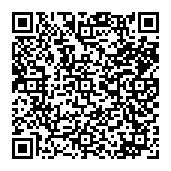
▼ Show Discussion